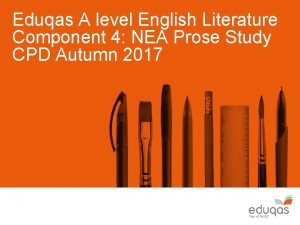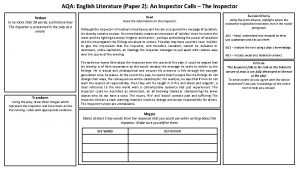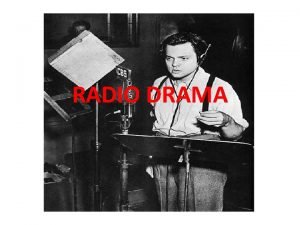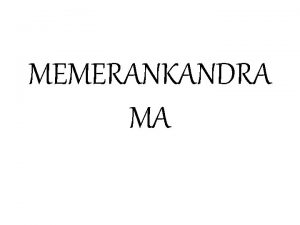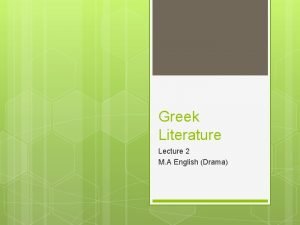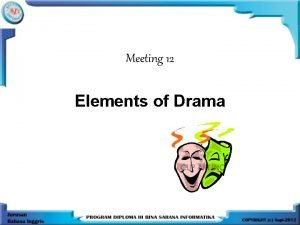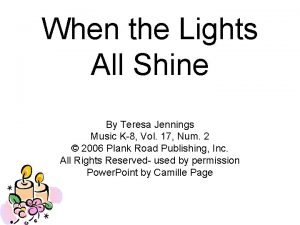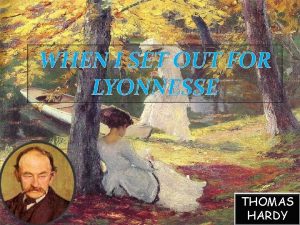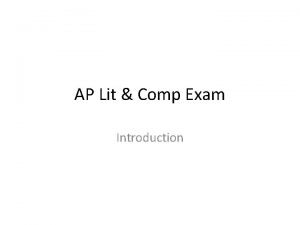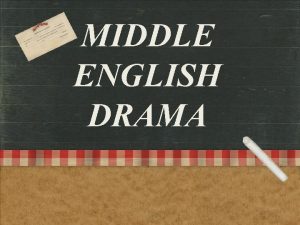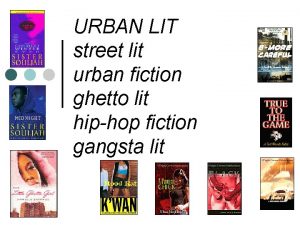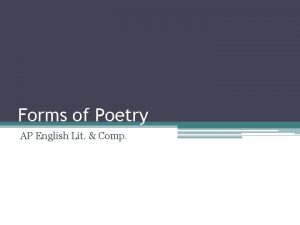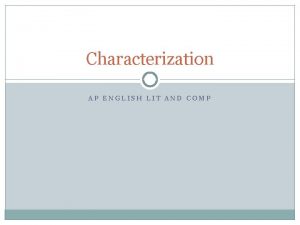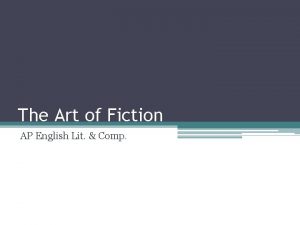Drama AP English Lit Comp Drama Drama is














- Slides: 14

Drama AP English Lit. & Comp.

Drama • Drama is a performed art. ▫ It comes to exist only through performance on a stage. If it is not performed it is simply fiction. • Drama is a visual form. ▫ Drama can exist without words, but it cannot exist without actors in motion, actors intending to be seen. • Drama is a collaborative form. ▫ Two or more people work together to create a production – the playwright, actors, director, etc.

Script • The text of the play that provides information that leads to the work of art – it is not the work of art in itself. • The performance is the work of art. ▫ Even Shakespeare only sold his plays to his acting company, not to printers. Only half of his plays even appeared in print during his lifetime.

Early Drama in England • The focus of early English drama was religious – often based on saint’s lives, Bible stories, or the temptations of allegorical figures representing humankind. • Amateur playwrights and actors performed plays on movable stages built on large wagons. ▫ Arena Stage – also called “theatre in the round” where the stage is set in the middle and the audience is seated all around.

Stages of Drama • In England, drama developed fully only after special buildings arose to hold such playing spaces in the 1570 s, ‘ 80 s, and ‘ 90 s. ▫ “Playhouse” – a pretending space ▫ “Theatre” – a seeing place

Theatres • Public theatres – cost was low, outdoor theatres, plays took place in the afternoon, could seat up to 2, 500 people. • Most common stages include: ▫ The “platform” or “thrust” stage, which jutted out into the middle, with audiences on three sides. ▫ Proscenium arch stage

Thrust Stages • The stage of late 1600 s theatres in London, performers did not strive to create and illusion of reality. ▫ Scenery and furnishings were simple and minimal ▫ Costumes were not perfect for time periods. ▫ Characters addressed audiences directly in soliloquys and asides, or might appear from the audience to interrupt a play already in progress. ▫ Characters who were supposed to be in two different places could appear on stage together.

Proscenium Arch Stage • Became the characteristic playing space of realistic drama in the late nineteenth century. • Became a medium for more realistic drama because it sets the performers apart from the audience, and functions as an illuminated box – the audience in the dark and lighting on the stage. • Detailed furnishings and costumes create illusion of reality.

Visualization • You can read drama well only if you know what these stages look like – arena, thrust, and proscenium. ▫ See the characters moving on these stages in your mind, letting the stage directions guide you.

Dialogue • As you must “see” in your mind to read drama well, you must also “hear” in your mind – to become sensitive to the art of dramatic dialogue. • To read drama well, clear from you mind the habits of reading fiction, and think of the work as performed by living people, speaking back and forth. ▫ Video

Questioning • As you respond to drama, you can also interpret drama, and express yourself by interpreting. To do this, we need to constantly be thinking in questions. ▫ What is the chief relationship in the play? ▫ What is the chief interpersonal conflict? �Drama depends on conflicts to be dramatic, and human drama depends on relationships.

Questioning Human Conflict • • • What does one character want from another? Why does this character want it so intensely? What does this character fear about another? What does this character fear this so intensely? What about the other way around? ▫ These questions should help you uncover information that is significant, valuable, and revealing.

Reading Aloud • Try to find in yourself the emotions appropriate to the character. • Express these emotions as you are reading. • This will help to think critically about how the characters would feel about a situation, and also allow you to express yourself as you read the parts.

Summary • Drama is a form that comes to exist only in a playing space. The more you play with drama–pretend with it–the better you will read. ▫ Play in your mind by seeing stages and performances. Let the playwrights' stage directions assist you. ▫ Play by reading dialogue aloud and listening for the give and take. ▫ Play by pretending the characters in a drama are alive and by asking questions about their wishes, their fears, and their relationships. ▫ Play by working as an actor, improvising. • The more you play with drama, the better you will read.
 Are english literature and language separate gcses
Are english literature and language separate gcses Eduqas english literature
Eduqas english literature Edexcel paper 1 literature
Edexcel paper 1 literature Eduqas a level literature
Eduqas a level literature Aqa english literature paper 2 2020 an inspector calls
Aqa english literature paper 2 2020 an inspector calls Drama serial drama serial
Drama serial drama serial Drama türleri
Drama türleri Radio drama format
Radio drama format Kata drama berasal
Kata drama berasal Greek drama in english literature
Greek drama in english literature Who is father of english drama
Who is father of english drama Jacobean drama in english literature
Jacobean drama in english literature Elements of drama theme
Elements of drama theme She lit a candle
She lit a candle What lit the poet's lonesomeness
What lit the poet's lonesomeness

